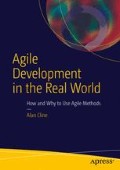Abstract
In the early days of agile, agilists wanted to avoid all upfront work before the iterations of requirements, coding, and testing started: no architecture, no initial requirements, not even getting their development environment set up. (The emergent design fans still use this approach.) I think this is an overreaction to the waterfall method. The pendulum of popular development style swung from too-much-upfront work to no-upfront work. Fortunately, that pendulum is swinging back to some upfront work that some agilists call upfront learning.
Access this chapter
Tax calculation will be finalised at checkout
Purchases are for personal use only
Notes
- 1.
Alistair Cockburn, one of the agilist patriarchs, announces this idea at a recent NFJS conference in Columbus, OH. Meyer (2014) and Guiteri (2011) have also published on the topic.
- 2.
Lean and Kanban are two of the popular agile approaches that do not require iterations, but work is often packaged into iterations for reporting purposes, and for periodic and frequent user demos.
- 3.
Scrum has no iteration 0, but does the same work in what it calls Sprint 1.
- 4.
I assume that the PM working in Region 2 works as the APM in the iterative Region 1 but this is not necessarily so. The APM should work on one project, but a Region 2 PM may work with many projects at a time, and sometimes called a program manager.
- 5.
For convenience, I will refer to a PM when talking about Region 2 activities, and APM when talking about Region 1 activities, where APM and agile coach are synonymous.
- 6.
A use case is comprised of a set of interactive paths, each one being a user story. It provides context for a set of related user stories, and is similar to an agile theme.
- 7.
Requirements modeling refers to building an object model of the problem domain, and validating it with a XUML sequence diagram to guarantee that no logical, control, or data errors exist; most ambiguities are removed too. This activity takes a few hours per use case, but does not impact the developer because the BA performs this exercise. The requirements model also helps the testers write test cases faster because they can leverage the model for testing. See Chapter 9.
- 8.
I will refer to the feature catalog after is it prioritized as the product backlog.
- 9.
As an exception, I recall one case of a networked application, built with open source tools by university students without a hard deadline, and the only cost was that of the CD on which to back it up.
- 10.
I have seen some cases where the PM took on an impossible project knowing that he could make changes later in the project. This approach depends on the flexibility of the management, and creates less of a career impact for the PM than saying “No” at the beginning of the project.
- 11.
Typical team velocity might be 14.3 story points per iteration. The decimal figure comes from the rolling window averaging of accomplished scope over five iterations.
Author information
Authors and Affiliations
Rights and permissions
Copyright information
© 2015 Alan Cline
About this chapter
Cite this chapter
Cline, A. (2015). Preparing the Project. In: Agile Development in the Real World. Apress, Berkeley, CA. https://doi.org/10.1007/978-1-4842-1679-8_4
Download citation
DOI: https://doi.org/10.1007/978-1-4842-1679-8_4
Publisher Name: Apress, Berkeley, CA
Print ISBN: 978-1-4842-1678-1
Online ISBN: 978-1-4842-1679-8
eBook Packages: Business and EconomicsApress Access BooksBusiness and Management (R0)

